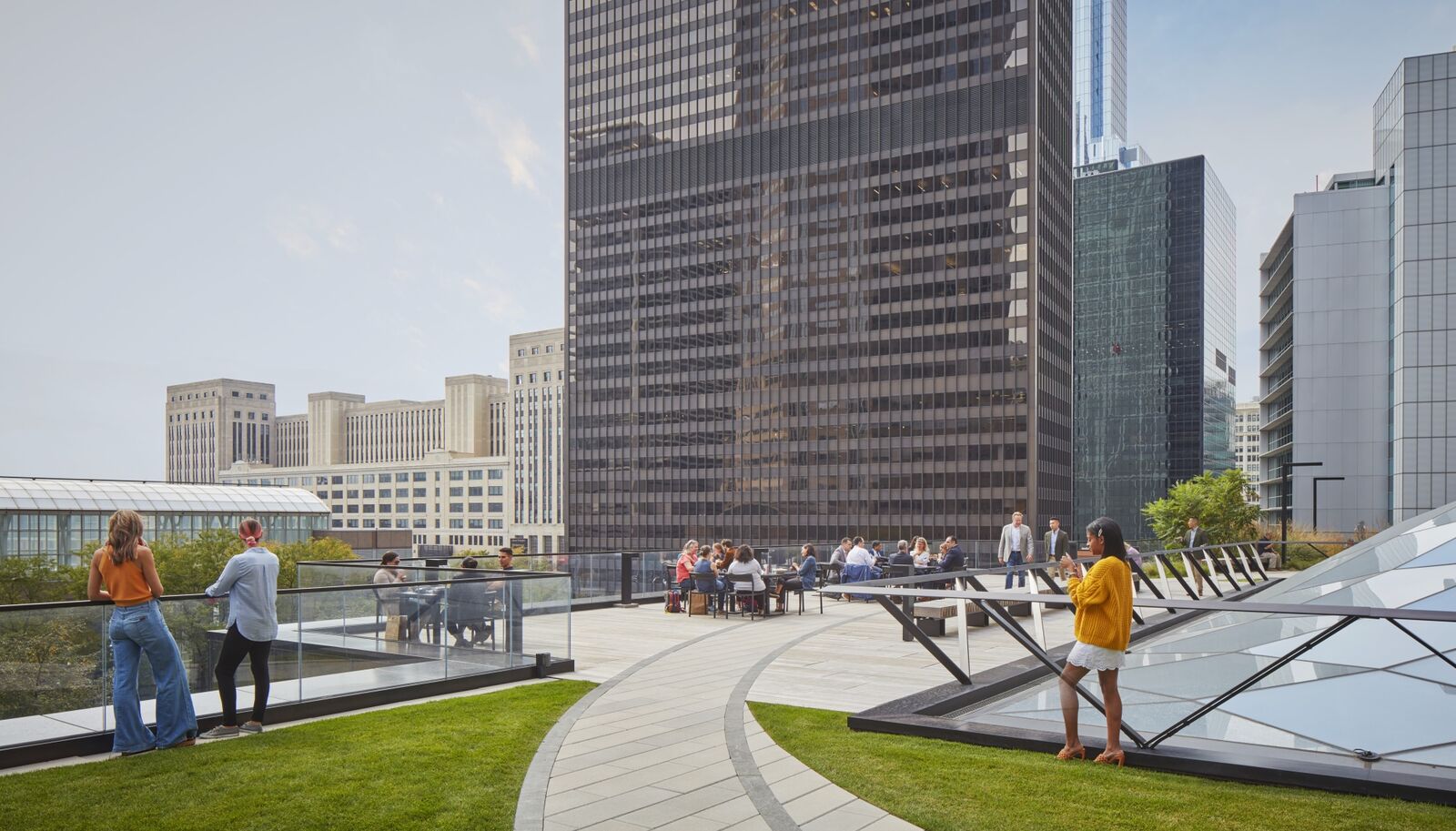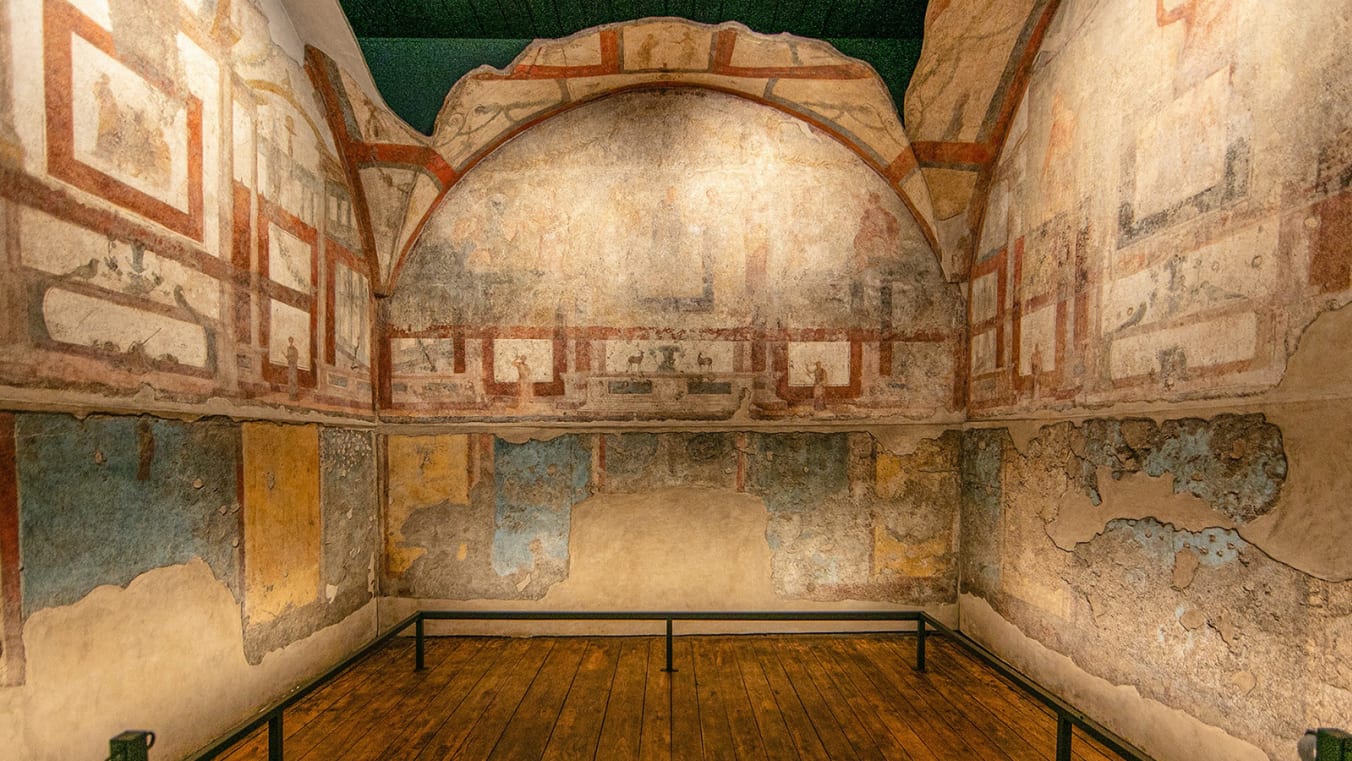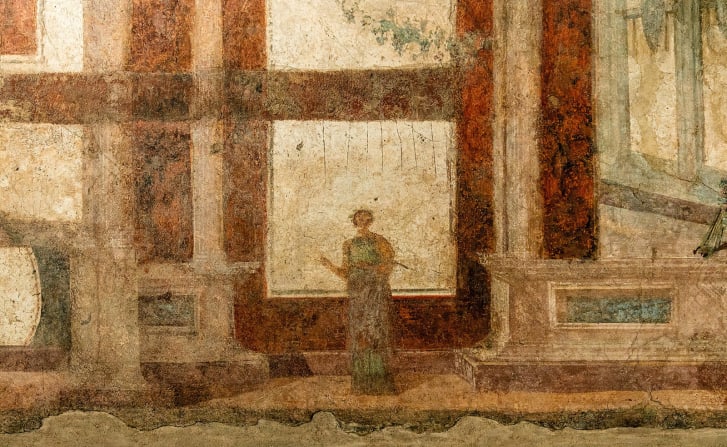In 2015, private equity giant Blackstone Inc. purchased the Willis (née Sears) Tower and began a half-billion-dollar renovation that would radically change the role the former tallest building in the world would play in downtown Chicago.
Today, anyone — not just workers in the 108-story office tower — can sample from a wide range of new public amenities inside the building. At a new multi-level food hall, you can grab breakfast at Do-Rite Donuts and Chicken or spend $19 on a bluefin tuna roll at Sushi San. The Color Factory, an interactive (as in: Instragrammable) art museum, opened up in June, beckoning tourists and locals with chromatic thirst traps. A 75,000-squre-foot conference center hosts group meetings, and weddings are in the works. On the tower’s podium, yoga classes and concerts can be held on a new 30,000-square-foot landscaped roof garden. Office workers in need of an early happy hour can find one in a new bar on the 33rd floor that opens at 3 pm.
And of course, you can go to all the way to the top: After taking in a museum experience recapping the high points of Chicago history and culture (the Great Fire, Mies Van der Rohe, deep-dish pizza), visitors to the Skydeck observatory rocket up to the 103rd floor for a view of the downtown Loop and Lake Michigan from 1,353 feet.
On recent Friday morning, the Tower’s new public spaces were bustling, with just as many stroller-hauling families as briefcase-toting office workers.
The Willis Tower’s redesign started before the pandemic, but it tracks how commercial real estate developers are thinking after Covid-19 changed the shape of work and life, shattering the connection between physical offices and productivity. “What Covid has done is really just accelerate what we were already doing before,” says David Moore, portfolio director and senior vice president at EQ Office, the Blackstone subsidiary that led the Willis Tower redevelopment.
To remain attractive investments, there’s a dawning awareness that large, quasi-public buildings need to be all things to all people, and that means hospitality-level consumer amenities. Old-school office towers like the ones that dominate downtown Chicago need compelling new reasons to pull people in. “We don’t build projects any more that are single-use,” says Todd Heiser of architecture firm Gensler, which designed the Willis Tower renovation.
In Chicago, the return-to-office process has stalled out: Backlogs of empty office space have been growing in the city over the last several months, with a record 21% vacancy rate at the end of March. Locally, only 41% percent of office workers showed up in person in mid-June, according to Kastle Systems, which tracks building access card swipes. That’s a bit worse than the US average, at 44%.
Transitioning office towers to branded consumer lifestyle experiences is one of several approaches that have been advanced for reinvigorating moribund downtowns, such as commercial-to-residential conversions that turn office space into living space. Ramon Marrades, an urban economist who’s the director of the nonprofit Placemaking Europe, sees the rapid acceleration of this trend as “an attempt from real estate linked to global capital to reinvent itself as quick as possible.”
If it succeeds, the add-more-amenities approach could enliven business districts with new derivations of privately owned public space — a zoning tool introduced by New York City in 1961 that encourages developers to make indoor or outdoor parts of their properties open to the general public in exchange for additional floor area. But the proliferation of these hybrid semi-public urban features has also raised concerns about exclusion and privacy. And a grimmer scenario awaits if this reinvention effort runs out of economic steam: Cities built around traditional office-laden business districts could be left with real estate craters at their hearts.
A Tall Order
The Willis Tower project offers a useful illustration of how buildings conceived for a different era of American work can be reconfigured. The skyscraper, an impressive but chilly Late Modernist icon completed in 1974, was a typically insular downtown presence; its street presence was opaque and fortress-like, with few openings and a desolate entrance plaza.
Today, the giant building announces itself more exuberantly. Its podium façade (designed by SkB) is wrapped in black steel mullions, and two of its entrances are framed by white terra cotta tiles; both are materials that speak to Chicago’s architectural history, and offer texture and human-scaled street presence. Inside are generous public lounges. The main entrance, leading to the food hall, is a series of glass and steel pavilions, next to an art installation by Olafur Eliasson.
The food hall (called Catalog, in a nod to the tower’s builder, the Sears & Roebuck Co.) takes up much of the added 250,000 new square feet of public amenities. Look up from here through a curved skylight (or from the roof terrace designed by Olin), and you’ll see the top of the tower.
EQ Office frames the revamped building as a kind of community center, welcoming workers, residents and passersby with dining, cultural amenities and outdoor space. Moore at EQ Office wants it to “embrace that downtown neighborhood, and become part of it, and to open your doors to it.” Heiser also mentions the project’s “commitment to inclusion.” That commitment extends to the placement of the tower’s “welcome desk” and its un-uniformed security staff, says Kirsten Hull, EQ Office’s vice president of development, which are designed to feel less invasive than a hard security checkpoint. Still, their existence also underlines the fact that, despite the rhetoric, these are not truly public places.
The Willis Tower also has some unique advantages — it’s a singular property that a wide constituency might want a part of. Beyond its status as the ex-tallest building in the world (a title it held until the arrival of Malaysia’s Petronas Twin Towers in 1998), it’s central to the city’s architectural history, as the flagship collaboration between SOM’s Bruce Graham and structural engineer Fazlur Khan. Almost two million tourists a year visit the Skydeck alone. As developers feel more pressure to get people in the door, such large and charismatic buildings will rise to the top, says Moore. “Not all buildings are created equal,” he says. “There are clearly going to be winners and losers.”
So what about office towers that don’t have Willis-Tower-sized advantages? Just a mile away, SOM’s new 19-story 800 Fulton Market, sited in the intensely gentrified Fulton Market neighborhood, illustrates another approach. Developer Thor Equities is looking to the building’s location, which Thor chief operating officer Melissa Gliatta says they are “crazy” about, to make the project viable.
Completed in late 2021, the building has the same suite of amenities that the Willis Tower does: public hotel-quality lounge space, a fitness center and conference center on the mezzanine level filled with local art, and soon, a café, restaurant and speakeasy. Visitors are welcomed with a dramatically cantilevered staircase and refined brick detailing that spells out its address across a wall. There’s a roof deck and outdoor terraces on every other floor. Almost 10% of the building’s square footage is devoted to amenities. Office workers who’ve been pecking at laptops in living rooms and coffee shops for two years may find that the building and its environs offer similar vibes.
The building was under construction during the pandemic, but Covid-19 brought an added focus on air quality and capacity monitoring. The developers enlisted technology company Buildings IOT to manage data picked up by the building’s sensors. “Being able to report that out to make the tenants feel comfortable was actually a big selling point for them as they were trying to lease the building during a pandemic,” says Julie Michiels, associate director and design leader at SOM. To prospective tenants, she adds, 800 Fulton’s builders were able to say, “You have access to the outside, you have fresh air being brought into the building on a cycle you can see and control.”
High-tech ventilation could be a boon for employers eager to lure Covid-wary staffers, but these sensors could also be used for more detailed — and potentially invasive — scans of environmental quality and occupant health, including contactless monitoring of body temperature and heart rate. Brian Turner, chief executive officer of Buildings IOT, says there’s not much demand for this technology yet. A different workplace frontier that the company is approaching involves collecting individual data on office workers’ preferred climate and environment thresholds. Employees could opt into a system that, once they walk through the front door, drops the blinds one-third down the window and sets the temperature at precisely 74 degrees.
In addition to offering bespoke comfort zones, such a feature would also give employers a more granular view of who is in the building, where they are, and what they’re doing. “We’re definitely going to be testing the waters a lot more with these applications, and challenging tenants and people with, ‘How much of your privacy are you willing to give up for [a] luxury or amenity,’” he says.
Future-Proofing the Office
In so many ways, the pandemic has been a system shock that’s redoubled efforts at future-proofing that architects have always been obsessed with. “The buildings we design are going to stay for another 50 years, and the trends and the users are changing every five years,” says Sejal Sonani of architecture and planning firm HLW.
That point was brought home with her renovation of the Union Bank Plaza, in downtown Los Angeles. Built in 1967, the 40-story tower was the tallest in the city when completed, at 516 feet. Sonani’s recent refresh includes the renovation of a conference center, a landscaped roof deck that’s open to the public, and refurbished dining and retail options, all adjacent to a historic Garret Eckbo landscape that sits on top of the building’s parking structure, that can hopefully tempt pedestrians to stop and linger. Intensely graphic and designed to be viewed from above in the office tower, its grid of trees creates an engaging counterpoint with the biomorphic pools and planters that spread across the site.
With the renovation under construction when the pandemic happened, Sonani and her team maximized flexibility and outdoor access as much as they could, making conference center rooms subdividable, and adding USB and Wi-Fi service in the outdoor plaza. “There’s an expectation that I’m going to see a café everywhere, any place could be used as a wine-tasting event or an art gallery, or a conference center,” she says.
It remains to be seen if meeting that expectation can be enough to buoy a battered downtown office space sector. The forecast of Union Bank Plaza isn’t rosy: Even with its new amenities, owner KBS Realty is looking to sell, and just cut its price tag by $85 million.
“These efforts to provide more amenities seem like a pretty desperate play,” says Nate Storring, co-executive director of the Project for Public Spaces, a nonprofit that aids the planning and design of public spaces with the people that use them. “They’re really doubling down on a strategy that they were already trying to do.” If these investments fail, it could “create some really bad fiscal pressure on downtowns that leads to very bad decisions.”
Instead of layering on new quasi-public amenities, Storring suggests focusing more on converting offices into residential units, which could both ease the housing crisis and help keep already-established downtown businesses alive. That approach is indeed being applied to skyscrapers of different vintages across the country: 41% of residential conversions over the last two years were originally office buildings.
Elsewhere in Chicago, for example, the ornate Tribune Tower is now home to luxury condos (converted prior to the pandemic) instead of newspaper reporters. Some of the same pre-war elegance can be had in downtown Cleveland for significantly less, as apartments for rent in the 1927 Terminal Tower go for as little as $1,000 a month. Buffalo, New York’s Seneca One tower, an SOM-designed office building that’s been the tallest feature on the city’s skyline since it was finished in 1972, was in foreclosure and nearly vacant in 2016; today, a developer has ushered a mix of new uses to re-activate it, including 115 apartments. One of the largest office-to-residential conversions began during the pandemic: New York City’s 55 Broad Street in Lower Manhattan, a 1967 tower that’s one-third empty, is being converted into nearly 600 apartments.
Blackstone, which owns Willis Tower, has also been active in the residential sector, buying rental housing, including single-family rental houses. But seeing developers move closer to consolidating the live/work/play trifecta under a single corporate gaze is not a prospect Storring relishes. “That you could be living, working, and playing all under a single owner is a scary thought,” he says.
Marrades of Placemaking Europe raises another concern: Packing office towers with amenities assumes there’s a nearly infinite appetite for branded lifestyle consumption. It’s a formula that requires a fundamentally sound consumer base with lots of disposable income — a combination that stubborn inflation, a potential recession, and an ongoing housing affordability crisis may gnaw away at. Whether they work there or not, people are likely to pay their rent before spending $38 on a lobster roll at the Willis Tower.
“We can talk about every fancy business district with amenities and ping-pong tables and whatever, but at the end, what we’re seeing is that there are people that are employed with decent salaries that cannot afford their house,” he says. “I have the impression that it’s about to collapse.”














